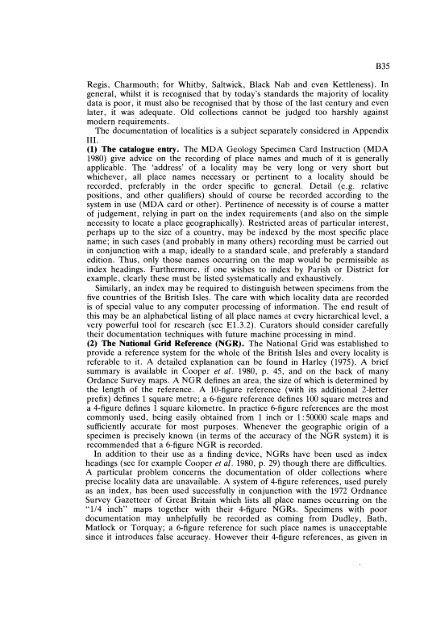GUIDELINES FOR THE CURATION OF GEOLOGICAL MATERIALS
GUIDELINES FOR THE CURATION OF GEOLOGICAL MATERIALS
GUIDELINES FOR THE CURATION OF GEOLOGICAL MATERIALS
You also want an ePaper? Increase the reach of your titles
YUMPU automatically turns print PDFs into web optimized ePapers that Google loves.
Regis, Charmouth; for Whitby, Saltwick, Black Nab and even Kettleness). In<br />
general, whilst it is recognised that by today's standards the majority of locality<br />
data is poor, it must also be recognised that by those of the last century and even<br />
later, it was adequate. Old collections cannot be judged too harshly against<br />
modern requirements.<br />
The documentation of localities is a subject separately considered in Appendix<br />
111.<br />
(1) The catalogue entry. The MDA Geology Specimen Card Instruction (MDA<br />
1980) give advice on the recording of place names and much of it is generally<br />
applicable. The 'address' of a locality may be very long or very short but<br />
whichever, all place names necessary or pertinent to a locality should be<br />
recorded, preferably in the order specific to general. Detail (e.g. relative<br />
positions, and other qualifiers) should of course be recorded according to the<br />
system in use (MDA card or other). Pertinence of necessity is of course a matter<br />
of judgement, relying in part on the index requirements (and also on the simple<br />
necessity to locate a place geographically). Restricted areas of particular interest,<br />
perhaps up to the size of a country, may be indexed by the most specific place<br />
name; in such cases (and probably in many others) recording must be carried out<br />
in conjunction with a map, ideally to a standard scale, and preferably a standard<br />
edition. Thus, only those names occurring on the map would be permissible as<br />
index headings. Furthermore, if one wishes to index by Parish or District for<br />
example, clearly these must be listed systematically and exhaustively.<br />
Similarly, an index may be required to distinguish between specimens from the<br />
five countries of the British Isles. The care with which locality data are recorded<br />
is of special value to any computer processing of information. The end result of<br />
this may be an alphabetical listing of all place names at every hierarchical level, a<br />
very powerful tool for research (see E1.3.2). Curators should consider carefully<br />
their documentation techniques with future machine processing in mind.<br />
(2) The National Grid Reference (NGR). The National Grid was established to<br />
provide a reference system for the whole of the British Isles and every locality is<br />
referable to it. A detailed explanation can be found in Harley (1975). A brief<br />
summary is available in Cooper et al. 1980, p. 45, and on the back of many<br />
Ordance Survey maps. A NGR defines an area, the size of which is determined by<br />
the length of the reference. A 10-figure reference (with its additional 2-letter<br />
prefix) defines 1square metre; a 6-figure reference defines 100 square metres and<br />
a 4-figure defines 1square kilometre. In practice 6figure references are the most<br />
commonly used, being easily obtained from 1 inch or 1:50000 scale maps and<br />
sufficiently accurate for most purposes. Whenever the geographic origin of a<br />
specimen is precisely known (in terms of the accuracy of the NGR system) it is<br />
recommended that a 6-figure NGR is recorded.<br />
In addition to their use as a finding device, NGRs have been used as index<br />
headings (see for example Cooper et al. 1980, p. 29) though there are difficulties.<br />
A particular problem concerns the documentation of older collections where<br />
precise locality data are unavailable. A system of 4-figure references, used purely<br />
as an index, has been used successfully in conjunction with the 1972 Ordnance<br />
Survey Gazetteer of Great Britain which lists all place names occurring on the<br />
"114 inch7' maps together with their 4-figure NGRs. Specimens with poor<br />
documentation may unhelpfully be recorded as coming from Dudley, Bath,<br />
Matlock or Torquay; a 6-figure reference for such place names is unacceptable<br />
since it introduces false accuracy. However their 4-figure references, as given in

















